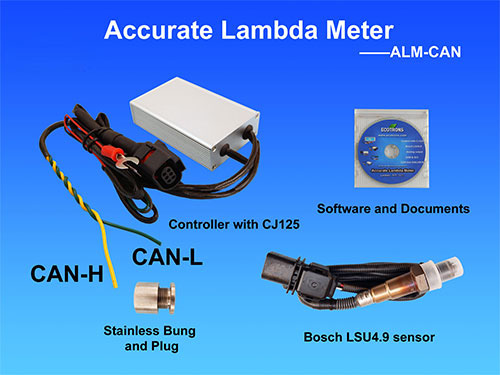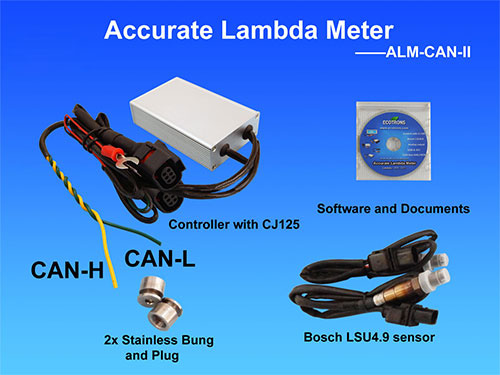 ALM-CAN (Accurate Lambda Meter with CAN bus supported)
ALM-CAN (Accurate Lambda Meter with CAN bus supported)
ALM (Accurate Lambda Meter) is an air-fuel-ratio (AFR) meter which uses the Bosch LSU4.9 or ADV sensor and Bosch semiconductor chip CJ125 to accurately measure the AFR or lambda for variant combustion engines. ALM-CAN is the version that comes with the auto industry standard CAN bus. This is the only wideband controller that has a open CAN bus protocols which can be vital for customers who have access to CAN bus. The CAN bus has been widely used in auto industries and especially in the engine control systems for years. There are tons of CAN bus based communication protocols published by SAE, ISO, CARB (California Air Resource Board). Multiple oxygen sensor related signals have been defined in those protocols. One specific protocol, SAE J1939, defines the oxygen concentration in the exhaust gas, which can be broadcasted by the sensor control moddule, or a wideband controller. By default, our ALM-CAN supports SAE J1939 protocol, and broadcasts O2 concentration. It also broadcasts lambda, sensor temperature, and sensor fault codes, etc. Further more, the CAN ID, baudrate, can be configured via ALM GUI. Our ALM-CAN has been used in many engine control applications and gas analyzing applications, where the main controller has already used the CAN bus to communicate with other control modules. ALM-CAN is kind of a perfect plug-and-play unit for the CAN bus based control systems. Any controller on the CAN bus can read the broadcasted O2% or Lambda, or other sensor info without any hardware changed. The protocols can be either standard, or customized. We do provide the customization of the protocols for small manufacturer applications. Another big advantage of the CAN bus communication to the 0-5V analog voltage output is accuracy. The CAN bus completely eliminates all the errors created by DAC (Digital to Analog Conversion) and ADC (Analog to Digital Conversion) conversions. The errors created by DAC and ADC alone can be as big as 0.02 lambda, depending on many factors: for example, the 5V reference voltage, which always has some errors; and the DAC, ADC chips, which are mostly 10 bit length and have rounding errors. Honestly, all wideband controllers that use the 0-5V analog output cannot be called "professional", and no OEM application uses that. You can also request to add a LED display to ALM-CAN and make it lab environment equipment. Again, ALM-CAN uses the more advanced LSU4.9 sensor instead of a LSU4.2 which is still used by most other wideband controllers. LSU4.9 is the new generation wideband sensor. It is superior to LSU4.2. One obvious proof is: Bosch uses LSU4.9 across the board for their wideband applications. (See the appendix: LSU4.2 vs LSU4.9) Click here to see why LSU 4.9 is superior to 4.2 Second, ALM uses Bosch chip CJ125 which is the integrated chip (IC) specifically designed for LSU 4.9/4.2 Sensors. With CJ125, ALM-CAN controls the sensor temperature in the close loop mode and precisely keeps the LSU4.9 sensor around 780 degree C. Note, Bosch's own wideband controller, "LambdaTronic, or LT4", uses CJ125 driver chip. In fact, Bosch uses this chip wherever a LSU sensor is used. The CJ125 and LSU sensor are mated-pair by Bosch. Presumably LSU sensors work the best with CJ125 chips.
 ALM-CAN-II (ALM-CAN with dual O2 sensors)
ALM-CAN-II (ALM-CAN with dual O2 sensors)
Recently, we added a dual sensor version of ALM-CAN-II. This version of ALM uses the same CAN bus protocols, but supports 2 LSU4.9 sensors. It is suitable to run with a V6 or V8 engine, where the 2 banks of the engine requires 2x O2 sensors. This dual sensor wideband controller is the more cost effective solution for the V-shape engines. One stone, two birds.
List of ALM-CAN parts
Small ALM controller with CAN bus built-in
large LED display (optional, for lab environment)
Harness (1.5 meter default, 3 meter optional)
Bosch LSU 4.9 sensor
Sensor plug and bung
CAN communication cable
USB to CAN converter (optional)
CD - documents and ALM GUI software (CAN bus based)
ALM-CAN technical specifications
Power supply
Input voltage range: DC 9V~15 V (12V Typical)
Input current: 50mA typical plus the heater current
Voltage protection : Reverse polarity protected, & overvoltage protected
Load Dump Clamp : Maximum voltage
Sensors
Compatible: LSU4.9 (LSU 4.2 capable but not recommended)
Number of Sensors: One
Measurement
Lambda range: λ = 0.55 ~ ∞ (Gasoline AFR: 8.08 to free air)
Lambda accuracy: ±0.008 @ λ=1.00
±0.01 @ λ=0.80
±0.05 @ λ=1.70
Air/Fuel Ratio: Fuel dependent (see lambda range and accuracy)
Free air calibration: No need (it measures the free air O2%)
Response time
internal 5ms updating rate (everything finished in 5ms)
250k, 500k, 1M CAN bus baudrate configurable
CAN message in 10ms broadcasting rate
Heater
Control built-in PID control with CJ125
Current Typical 1A; Max 1.7A
Heater return (H-) Separate wire from Ground
Output
CAN bus signals, default SAE J1939 protocols
Broadcasted signals: O2 concentration, lambda, sensor temperature, heater duty cycle, and sensor fault codes
Signal accuracy: all 16 bit values
Lambda analog output: 0~5V user programmable (optional, not included)
Data logging: any CAN bus based data logger compatible
User-friendly PC software for customer configurations and settings
Main-Processor
CPU: FreeScale 16-bit micro-processor S12P (auto industry rated)
Speed: 32MHz
Memory: 128k Flash, 6k Ram, 4k Data
Load Dump Clamp
Maximum voltage
Special features
On-Board-Diagnosis and error report
Self-learning of part-to-part variations, aging effect
Working with different types of fuels (gasoline, diesel, E85, etc)
General
Temperature range: -40C ~ +110 C (can be installed in the engine compartment)
Dimensions: 4" x 2.6" x 1"
 ALM-CAN manual - v2.6
ALM-CAN manual - v2.6 
 ALM Communication Protocol - CAN- v1.9
ALM Communication Protocol - CAN- v1.9 
 ALM GUI User Manual - v1.3
ALM GUI User Manual - v1.3  software
software
 ALM GUI Setup - v2.9.16
ALM GUI Setup - v2.9.16
| Characteristics | LSU4.2 | LSU4.9 | Notes |
| lambda range | lambda = 0.65 ~ ∞ | lambda = 0.65 ~ ∞ | |
| Accuracy | only good at lambda = 1 or moderate rich |
accurate at both rich and lean, wider range |
LSU4.2 is only accuracy at lambda ≈1 and moderate rich, between 0.8~1.0 lambda; LSU4.9 has better accuracy in both rich and lean conditions, suitable for gasoline, diesel, CNG, etc. |
| Response time | Slower | Faster | Thinner sensing element of LSU 4.9 makes it more responsive to the AFR change, dynamically more accurate, and easier to light off, less heating power needed. |
| Heating power | 10W | 7.5W | LSU4.2 has the off-centered-heater vs. LSU 4.9 has the centered-heater in the laminate; LSU4.9 has better heating efficiency, less heating power needed. |
| Free air calibrations |
needed | not needed | LSU4.2 is susceptible to reference air contaminations, which is called CSD (characteristic shift down), requires frequent free-air calibrations. LSU4.9 uses reference pump current instead of reference air. No more CSD. No requirement of free-air calibrations |
| Nernst cell resistance vs. temperature |
80~750C | 30~790C | LSU4.9 has higher resolution of internal resistance vs. temperature characteristics, which makes the temperature measurement more accurate, and better heater control, therefore higher accuracy of lambda. |
| Light off time | long | short | LSU4.9 lights off faster. Lambda controls can be active much faster during warm up phase. |
| Reliability | Improved reliability | LSU4.9 is superior to LSU4.2 with regard to the reliability and life. | |
| Check with Bosch | Still selling it | Recommended | Bosch recommends LSU4.9 to all OEMs. Bosch uses LSU4.9 for its own wideband controller. http://www.bosch-motorsport.de/media/catalog_resources/Lambdatronic_LT4_Datasheet_51_en_2785631627pdf.pdf |
Please contact us at info@ecotrons.com for purchase and other inquiries.







